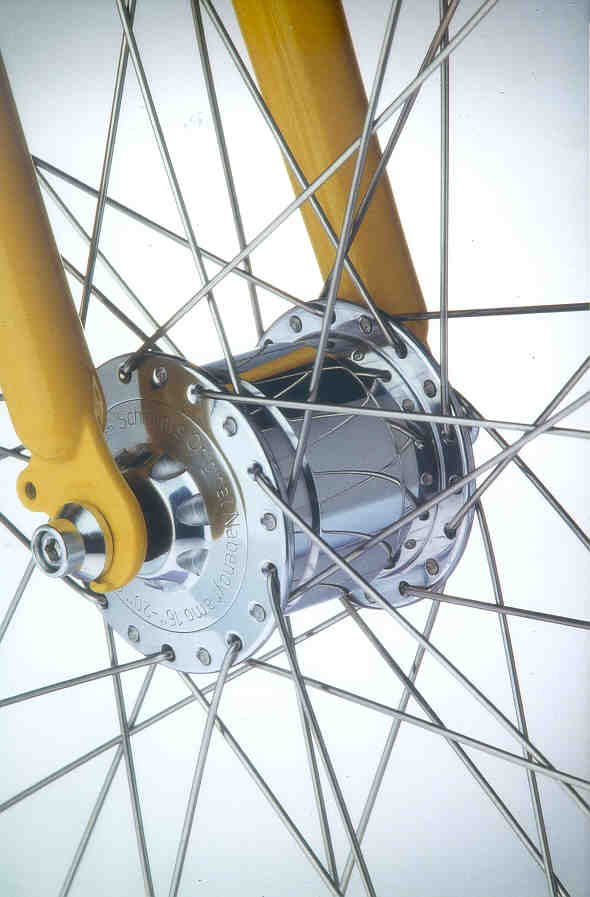 The
SON
hubdynamo is a AC dynamo with a rotating magnet, of the same type as
found
in bottle dynamo's. However dimensioning is such that at low speeds
sufficient
power is produced. Small size hasn't been pursued (there is plenty of
room
between the forklegs) but every effort has been taken to keep the
weight
down. The characteristic of the dynamo is such that under load the
voltage
rises with speed upto a certain limit (eg 7.0v) An electronic
controler,
eg with current eating Zehner diodes is superfluous. The
SON
hubdynamo is a AC dynamo with a rotating magnet, of the same type as
found
in bottle dynamo's. However dimensioning is such that at low speeds
sufficient
power is produced. Small size hasn't been pursued (there is plenty of
room
between the forklegs) but every effort has been taken to keep the
weight
down. The characteristic of the dynamo is such that under load the
voltage
rises with speed upto a certain limit (eg 7.0v) An electronic
controler,
eg with current eating Zehner diodes is superfluous.
If you rotate the axle by
hand, you will feel the magnet poles attracting the stator, which gives
the impression of a maladjusted bearing. As long as no current flows,
the
losses are very small due to the hysteresis characteristics of the
materials
chosen. First when the circuit is completed and current flows, the
windings
will act as a electromagnet and mechanical energy will be transformed.
Another typical characteristic of the SON is the flashing of
the
lights at low speeds (upto ca 5 mph, 8 km/h). This is caused by the
then
low frequency of the current, at higher speeds the eye will see a
continuous
beam. In practice this isn't bothersome, and cosmetic solutions to get
rid of it will hurt efficiency. And it makes the cyclist more
noticable,
at times when there isn't much light to start with.
The hub runs on two sealed
industrial bearings. One bearing is permitted to move axialy, so that
it
will never bind. This is a common practice in enginering design, but
one
which never seems to make it to bicycle parts! Another thoughtfull
detail
is the very stiff axle and the extra gapseal. In the improbable event
of
a bearing needing replacement, the complete unit can be unscrewed from
the hub with a special tool. (with the previous model SON the
spokes
needed to be removed first).

The hollow axle is made from
high quality stainless steel. Standard the hub is supplied with a 5mm
inhex
axle, but a normal quickrelease can be substituted if required.
Electrical installation
As
the dynamo always turns the
lights can be switched on electrically. The standard solution is to use
the Lumotec c.q. Lumotec oval plus headlights modified by SON with a
rocker
switch and heavy duty coax wiring and fitted plugs. This is very
reliable
and easy to fit. Coax wiring is used, as it is neat and strong. Two
'real'
4.8mm plugs complete the connection to the dynamo.
For a rear light we recommend
an efficient and reliable LED light, as the 4D-lite plus or Dtoplight
plus
with 'afterburner' from B&M. The rear light is connected to the
headlight
with a 2.8mm plug. (note in Germany it is illegal to have a separate
switch
for the rearlight, which prevents the other excellent solution of a
LEDlight
with a battery (use with a 3watt bulb)
in that market).
A Lumotec Oval senso plus
is also available, which switches on automatically in the dark.
Power
The
power and current characteristics
of the SON are -as with any other dynamo- defined by the type-approval
regulations. The losses however are about a factor two smaller, which
makes
the switching on of the lights hardly detectable. (we do recommend to
turn
off the lights in daylight as bulblife is limited, and to stop fellow
cyclist
from warning you all the time ;-) ).
Schmidt original?
Direct
drive hubdynamo's are
pretty old (eg Sturmey Archer built one in the fifties, which had 2.5v
output, and weighted 1.1 kg) Only in 1992 Wilfried Schmidt managed to
design
with modern materials a hubdynamo which could and deliver 3
watts,
and
wasn't much heavier than a conventional hub plus dynamo. In 1995
Wilfried
Schmidt started his own company to produce dynamo's, to ensure that his
high quality standards would be kept. Several other hubdynamo's are now
available, all cheaper, but also of lower performance. And SON's are
continuously
being improved, the latest version is smaller, lighter, and the
unloaded
losses were halved! |